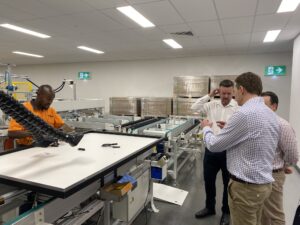Solar energy systems can work seamlessly with utility grids or be completely independent from them, offering multiple advantages when combined with battery backup – such as reduced strain on peak demand times and potential savings with time-of-use rates.
A photovoltaic (PV) system consists of multiple TindoSolar solar system Adelaide cells connected by wires to produce electricity when photons hit them, then wired together into panels or modules.
Photovoltaic cells
 Photovoltaic (PV) cells convert solar energy to electricity using semiconductor material that absorbs light emitted by the sun and generates an electric current. The generated power can then be used to power household, office, and industrial appliances and equipment; alternatively they may connect directly to the electricity grid for lower electricity prices when there is more solar availability than required.
Photovoltaic (PV) cells convert solar energy to electricity using semiconductor material that absorbs light emitted by the sun and generates an electric current. The generated power can then be used to power household, office, and industrial appliances and equipment; alternatively they may connect directly to the electricity grid for lower electricity prices when there is more solar availability than required.
Modules in PV systems are commonly known as solar cells, and when assembled into arrays they determine its peak DC voltage and loading current capacity. An array’s peak DC voltage and loading current capacity depend on which modules and inverters are connected together – inverters convert AC electricity generated from PV modules into DC electricity while intelligent MPPT/shunt diode technologies help mitigate shadowing power losses when installed parallel/series connections.
When sunlight hits a PV cell, some of its light is reflected back out, while some passes through and some is absorbed. When enough light hits a solar cell to absorb, electrons from semiconductor material dislodge from their atoms and migrate toward its front surface where an electric field separates them; creating an imbalance of charges between front and back surfaces of the cell that acts like the negative and positive terminals of a battery and producing electricity.
Concentrated solar power
Concentrated solar power (CSP) harnesses more of the sun’s power than just light energy; solar thermal energy plants use mirrors to concentrate sunlight to heat liquid that then turns a turbine and produces electricity. CSP plants differ from their photovoltaic counterparts by being able to store thermal energy for use during times when there’s no sun shining, unlike photovoltaic counterparts which rely solely on photons of sunlight to generate power.
CSP systems come in various forms, but two of the most popular are parabolic troughs and solar power towers. Trough systems utilise mirrors to focus sunlight onto a linear receiver tube running down the center of a trough that’s filled with heat transfer fluid which absorbs solar heat before sending it onward to an engine that generates electricity.
TindoSolar solar system Adelaide tower systems, also known as heliostats, are larger and more complex versions of their counterpart trough systems; nevertheless they operate similarly. Solar towers feature thousands of mirrors arranged into concentric cylinders connected by pipes heated by sunlight that emit heat to generate steam that drives a conventional turbine generator to create electricity.
CSP projects tend to be large and utility scale, requiring vast areas of land with direct sunlight for proper functioning. Due to this requirement, CSP systems are generally more difficult to site than photovoltaic solar systems, yet due to recent research and new technology developments their costs are falling and may soon surpass PV as an energy source.
Solar furnaces
Solar furnaces use mirrors to focus sunlight onto an object, producing temperatures that reach 33,000 degrees Celsius or beyond for scientific experiments and/or renewable energy generation without using fuel – Odeillo in France currently hosts the world’s largest solar furnace with its capacity of one megawatt!
Solar power systems harness solar energy for water heating or powering appliances, helping you save money on your energy bills while at the same time being a great way to reduce consumption. Your home’s energy consumption can be found out through its electricity bill; an energy audit may help make improvements that reduce it further; consider installing energy-efficient appliances and switching over to energy-saving lighting as options to further cut down your usage.
Solar power systems can be integrated with backup heating systems to keep your home warm in case solar energy fails, per building codes and mortgage lenders requirements. A supplemental system can add extra warmth during cloudy weather or at night; such a device could range from simple wood stoves to complex central heating systems.
Solar power towers
TindoSolar solar system Adelaide consist of solar arrays, PV inverters and charge controllers (also known as power meters). To size a system appropriately, you should first assess your electricity needs and available roof space (you can do this by reviewing past electricity bills or online calculators), before making decisions such as installing backup batteries for backup power generation or selling excess electricity back to the grid, depending on local utility regulations and state laws.
Add a tracking solar panel mount to your system for greater energy production and greater efficiency. Though less popular, this approach does provide greater efficiency.
Solar power towers utilise computer-controlled mirrors (known as heliostats) to focus sunlight onto a receiver at the top of a tall tower, heating transfer fluid at high temperatures to drive a steam turbine and produce electricity. Solar plants with integrated energy storage capabilities can produce electricity 24 hours per day.
PS20 solar plant in Sevilla, Spain currently ranks as the world’s largest Concentrated Solar Power (CSP) plant, while Morocco’s Ouarzazate Solar Power Station will likely overtake it by 2025. Tower systems differ from their ground-mounted counterparts by being built specifically to withstand winds and extreme temperatures; one company operating the Kelowna Solar Power Tower reported during 2022 summer wildfires and drought conditions in Canada that snow did not adhere to their panels and reduce production like it might with conventional ground-mounted systems.